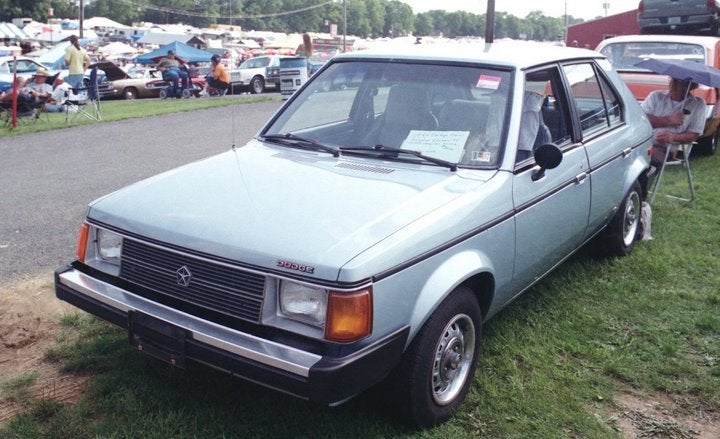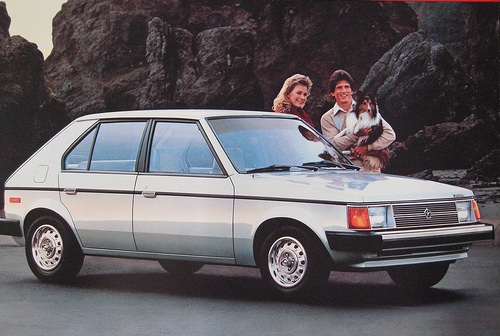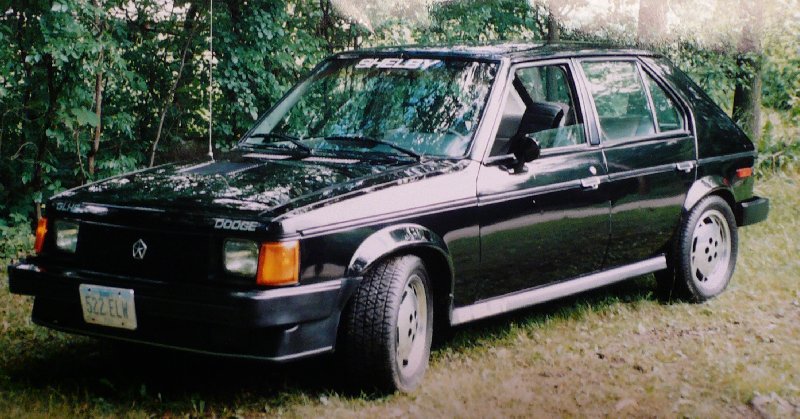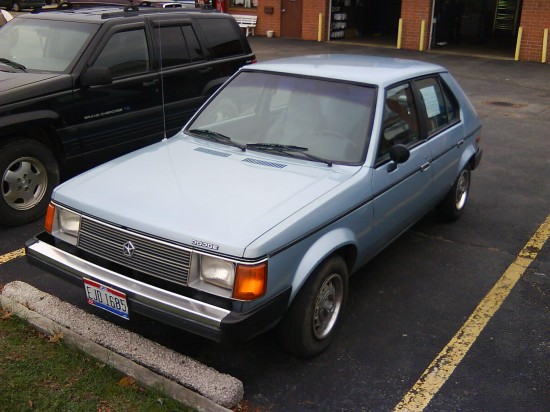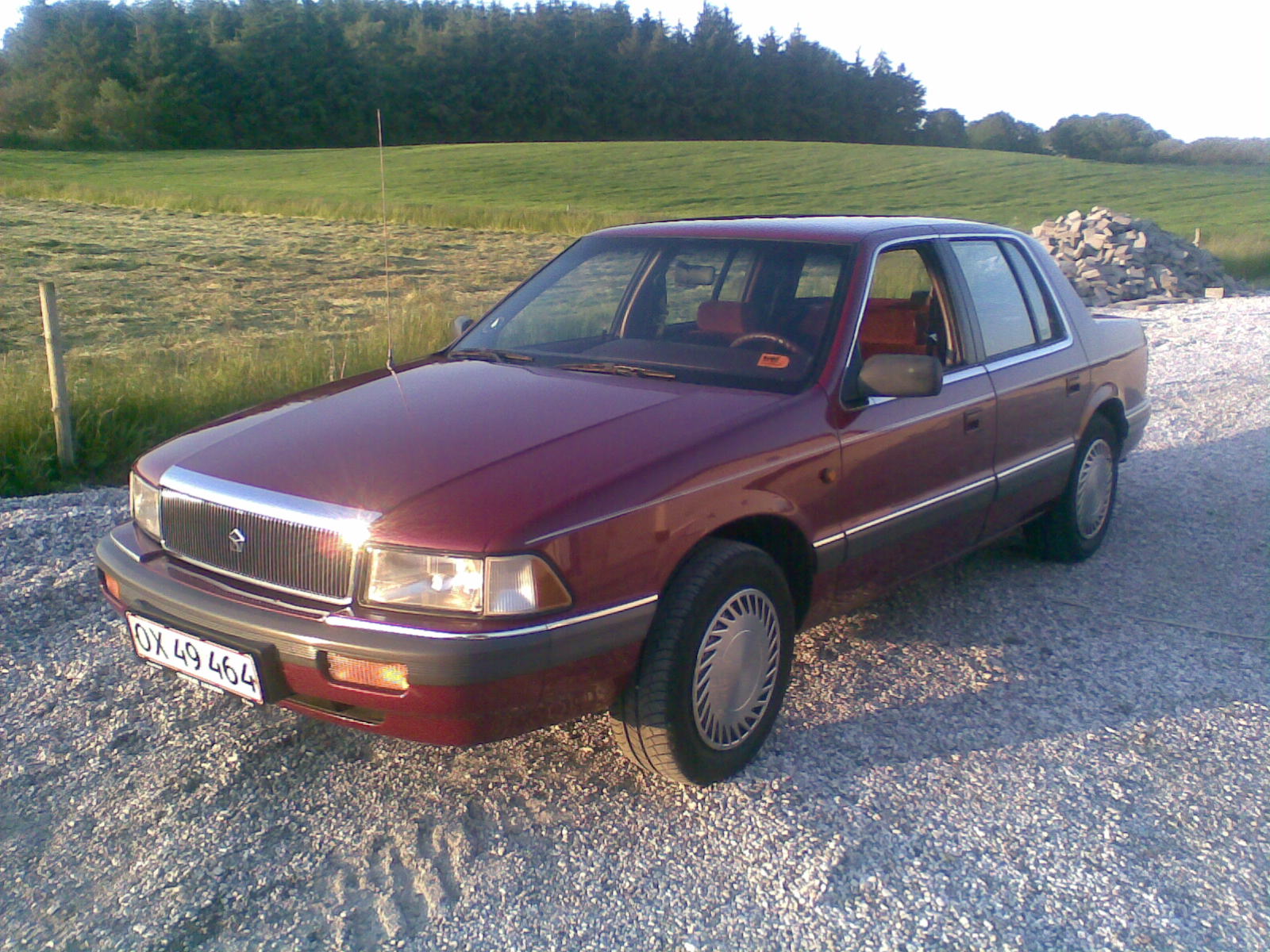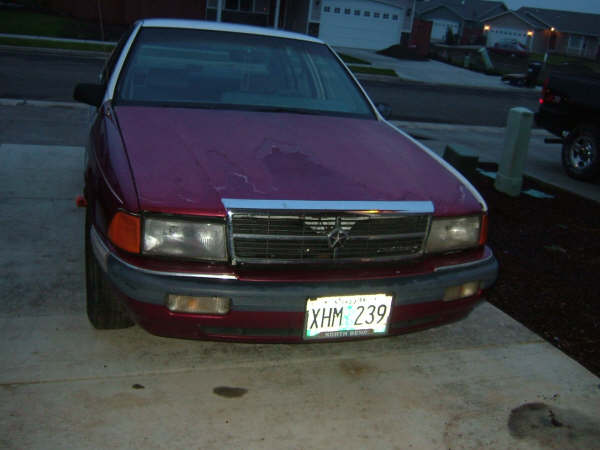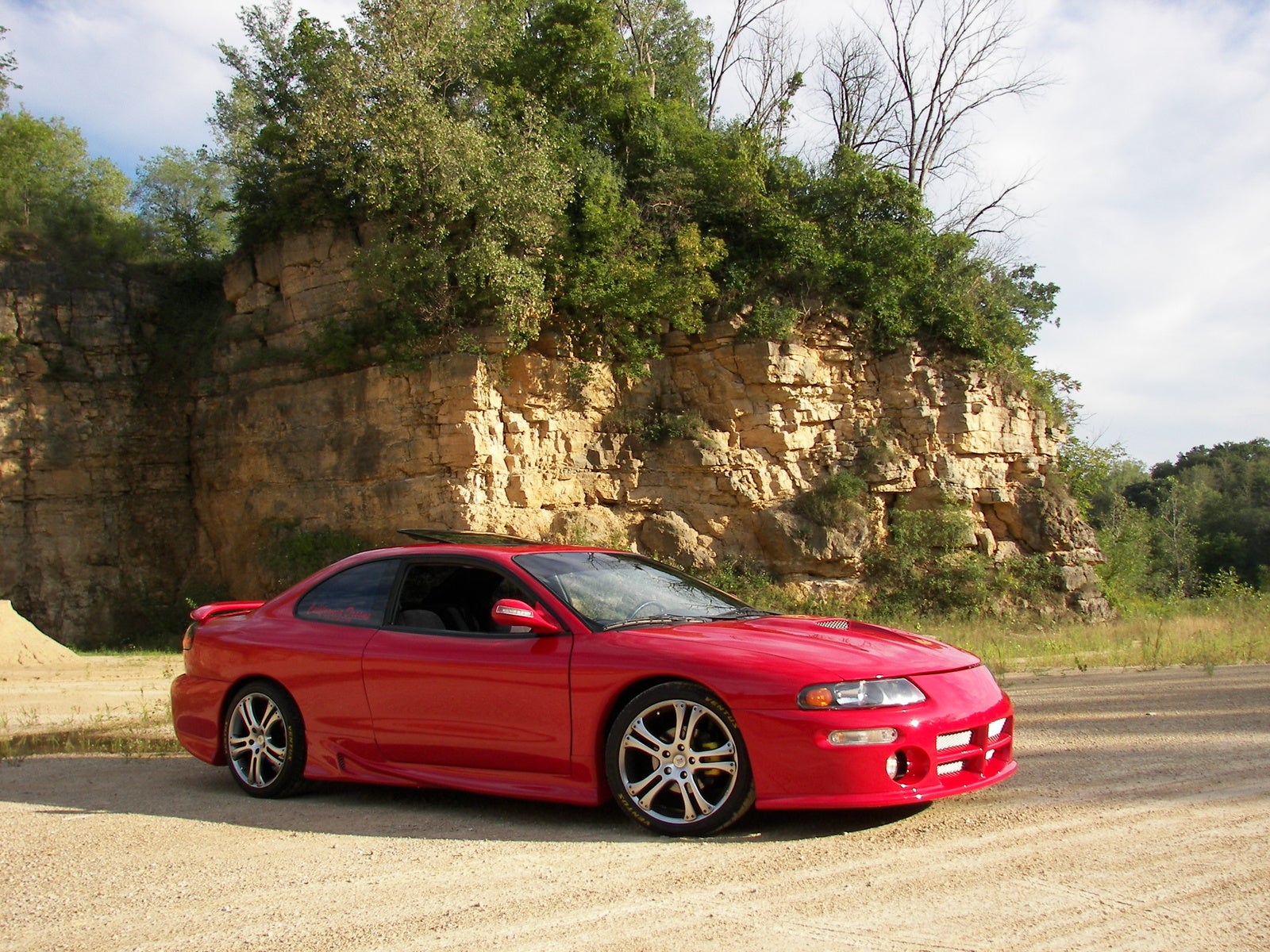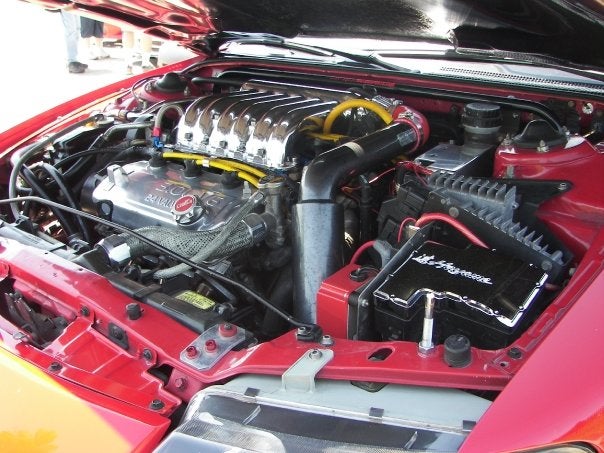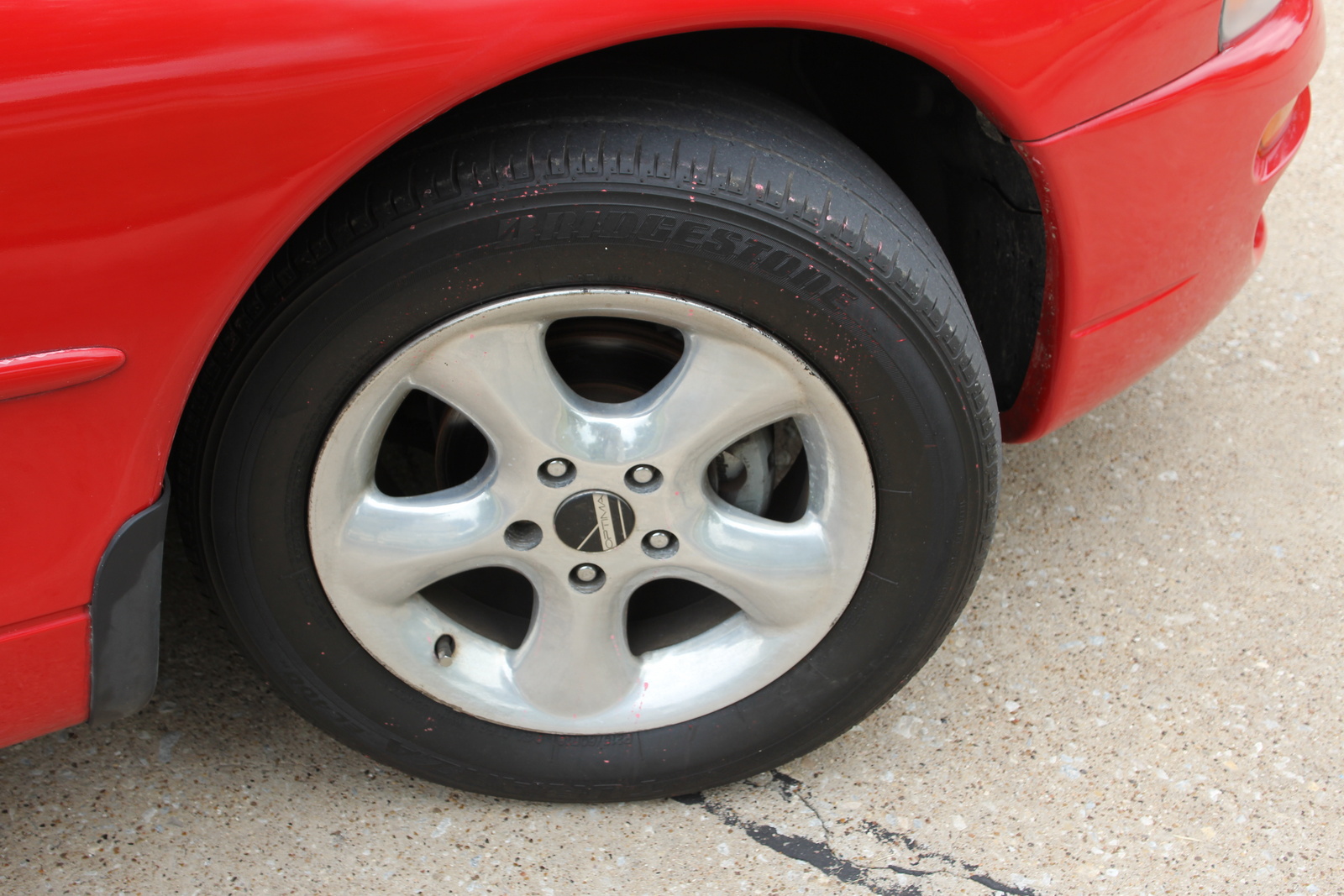Dodge Dynasty
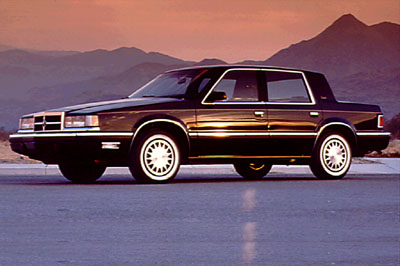
The AC-body was introduced in 1988 as the Dodge Dynasty and Chrysler
New Yorker. The Dynasty was available in base and LE versions, using
the 2.5 L 4-cylinder as a base engine. That engine was new to Chrysler and featured
multiple-point injection. The New Yorker and Dynasty LE had a standard 3.0 Mitsubishi V6, which was also an option on the base Dynasty; it had a full 1/3 (50)
extra horsepower. Chrysler considered the New Yorker Landau to be a
separate model at the time, the main differences being a vinyl landau
roof and standard load-levelling suspension and Infinity stereo.
The New Yorker joined an existing New Yorker model, which was renamed
New Yorker Turbo for 1988. In that year, the Fifth Avenue was still
based on the Diplomat/Gran Fury, and would remain so until 1989, so the
New Yorker name was now split from the Fifth Avenue model for the time
being.
The Dynasty and New Yorker were similar in architecture to all the various extended K-cars,
with a similar suspension, solid rear axle, and common components under
the hood and in the chassis; various visible parts were also shared,
including the steering column, stereos, and climate controls. The
Dynasty bucked the trend of console-mounted shifters and stuck with the
tried-and-true column shift, though.

Dynasty and New Yorker got new front struts to reduce ride harshness
and noise; partly grooved cylinders allowed hydraulic fluid to bypass
the strut piston in normal driving, but under poor conditions the strut
piston slid past the end of the grooves, increasing resistance and
reducing the impact of the suspension against its internal stops. This
was a domestic industry first. The Dynasty and New Yorker also had an
optional power truck lid pull-down mechanism. They also had an
electrically driven speedometer and odometer.
In 1990, the dashboard was changed slightly and the 3.3 V6 was added to the option list (the 3.8, too, but we'll get into that
later). Also in 1990, the platform was stretched slightly to create the
Fifth Avenue and Imperial (Fifth Avenue had 3.3 standard, 3.8 optional -
Imperial had 3.8 standard). The only real difference was the rear doors
were a bit longer. Also, the front end on the Chrysler models was given
a sloping treatment, but otherwise looked the same. Dynasty was never
changed on the outside.
The dashboard used from 1990 to the end was similar in many ways to
the older big-body cars, but considerably smaller. Switchgear felt
rather dated even at the time, with a feel from the 1970s. Indeed, the
Dynasty was a good option for those who missed their Polara’s interior.

|
|
These cars were the only EEK (K-based) Chrysler, Plymouth, or Dodge
cars to use either the 3.3 or 3.8 liter engines, which were otherwised
reserved for minivans until the LH series was produced. The Fifth Avenue
and Imperial remain the only cars to use the 3.8 engine.
[Webmaster addition: the Imperial was generally viewed favorably by
the press for its ride and fuel economy, and was rated highest in
quality among domestic cars by Consumer Attitude Research. However, one
magazine suggested that its dismal sales were probably due to the lack
of a V-8, which was desired more as a status symbol ("price of entry")
than for its actual acceleration.]
There
was a base New Yorker model offered in the early 90s-a badge-engineered
Dynasty. The only difference was the grille didn't have the Dodge
"gunsights." All other things were identical.
The Canadian version was known as the Chrysler Dynasty. I know of no European export version of these cars.
The 3.3 engine made the car perform quite well - my 1993 Dynasty
(with 152,000 miles on the clock as of this writing) handily beat both a
Beretta GTU (it has decals, so it's gotta be fast!) and a '98 Ranger
Splash with the 4.0 liter V6. Almost kept up with a 5-point-slow
Mustang! This was probably the strongest of all the older front wheel
drive Mopars since it used all the heavier-duty minivan underpinnings.
Features
Dynasty and New Yorker front struts were unique to American cars at
the time, and were specially designed to reduce ride harshness and
noise; partly grooved cylinders allowed hydraulic fluid to bypass the
strut piston in normal driving, but under poor conditions the strut
piston slid past the end of the grooves, increasing resistance and
reducing the impact of the suspension against its internal stops. The
Dynasty and New Yorker also had an optional power trunk lid pull-down
mechanism and load-adjusting suspension. Basic suspension design and
other engineering features were similar to other contemporary models.
Chrysler New Yorker introduction materials (written by Chrysler in 1988)
Chrysler is introducing an all-new, larger series of front-wheel
drive luxury sedans for the 1988 model year. They'll wear the
prestigious New Yorker and New Yorker Landau nameplates. While retaining
the name that has graced Chrysler's full-size, top-of-the-line sedans
for almost half a century, these longer, roomier, more luxurious
four-door models provide all the features that buyers of large sedans
seek: formal appearance, confident performance, assured handling, quiet
riding comfort, luxurious appointments, and an array of convenience
features. And they are backed by an outstanding warranty.
Styling is elegant in both the highline New Yorker model with its
crisply designed all-new utitized body, and in the premium Landau
version, distinguished by its formal, padded vinyl landau roof, and a
more opulent level of equipment. Both are distinguished by an impressive
waterfall-design grille flanked by concealed headlamps.
Built
on a 104.3-inch wheelbase and measuring 193.6 inches overall, the New
Yorker and New Yorker Landau provide seating for up to six occupants
plus a 16.5-cubic foot luggage compartment.
The New Yorker and Landau models feature Chrysler Motors' first
passenger car use of the 3.0-liter V6 electronic fuel-injected engine
coupled with 3-speed automatic transmission and fuel saving lockup
torque converter as standard equipment.
Estimated EPA fuel economy is 19mpg city/25 mpg highway, providing
extensive range.
Other key features are 18:1-ratio precision feel power steering, a
redesigned and specially-tuned suspension with new design struts and
gas-charged shocks, an automatic load-leveling system (standard on the
Landau), power front disc brakes and automatically adjustable rear drum
brakes, or optional four wheel power disc brakes with anti-lock system.
The well-appointed interiors provide quiet-riding comfort on
inviting "loose pillow" type front seats in the Landau and elegant
pleated cloth seats in the New Yorker. Mark Cross leather interior
packages are optional.
Full analog gauge instrumentation with electric analog speedometer
and graphic message center is standard on New Yorker. The Landau has
full electronic digital instrumentation and a mini trip computer.
Standard radio is a 4-speaker AM stereo/FM stereo. Optional cassette
systems with 8 Infinity brand speakers are designed to provide concert
hall quality.
Convenience features include a new Automatic Temperature Control air
conditioning/heater system, remote hood, trunk and fuel filler door
releases; 50-50 split bench front seats with individual seat back
recliners; front and rear folding center arm rests; front and rear
reading lamps; interior courtesy lights; dual visor vanity mirrors; dual
heated power side mirrors; an electric rear window defogger; side
window demisters, intermittent wipers, plus cupholders and map pockets.
The deck lid opens from bumper level for loading ease, and a power deck
lid pull down mechanism is optional.
Standard equipment in the Landau includes nearly all of the above
plus automatic power door locks, a power 6-way driver's seat, tilt
steering column with leather wrapped wheel, electric speed control,
front seat back assist straps, and luxury wheel covers.
Convenience options include an Electronic Vehicle Information Center
with numerous vehicle system displays, including compass and outside
temperature displays in an overhead console, lighted vanity mirrors,
power radio antenna, dual headphone jacks (for Infinity systems) mounted
in the rear shelf panel, and a power dual action sun roof. Options are
available in selected groups in discount packages.
Seat belt systems include low-tension unibelts for front outboard
passengers and lap belts for center positions and for rear outboard
passengers. The Landau provides vertically adjustable head restraints
for outboard rear occupants as well as 4-way adjustable head restraints
for front occupants.
The cars had 5 mph front and rear bumpers; front fender and quarter
panel moldings were fitted close to the bumper. A spring-loaded design
in the end of the molding allows the bumper to force the quarter
moldings away from the body in event of impact then return them to
normal alignment.
Adding to appearance, these cars have aircraft-type curved doors and
flush windshield and back window glass.
These new models have received 37 different treatments for noise,
vibration, and harshness control. For corrosion protection Chrysler uses
galvanized body panels and a stainless steel exhaust system, and metal
moldings are co-extruded with PVC plastic or otherwise isolated from
body metal. The new sedans are available in 10 exterior colors applied
with an exclusive paint system that improves clarity and gloss of the
finish. It is the only twocomponent clear coat process in the industry.
Exterior colors are coordinated with a choice of four interior colors.
Drew reviews the 1991 Dodge Dynasty LE (written in 1991)
My great-uncle Harvey was a conservative, upstanding sort of guy who
always drove big, full-sized Dodge 4-door sedans. Uncle Harvey would
undoubtedly like the 1991 Dodge Dynasty. The Dynasty looks a lot like
how I remember Harvey's cars, but maybe at about 7/8ths scale (Harvey's
last car was a huge 1965 Dodge Custom 880 sedan, if I remember right).
The Dynasty exhibits lots of straight lines and near-right angles,
without much concession to aerodynamic trendiness. In short, it
looks—well, conservative and upstanding.
I personally like the looks of the Dynasty, though my wife thinks it
looks "old-fashioned". Maybe that's part of the appeal for me. The car
has
traditional American value written all over it, from its distinctly squared off roof to its no-nonsense rectangular grille.
This impression doesn't change once inside the car, either. The seats
look comfortable and well-designed, but there's nothing particularly
flashy about them; just nice, conservative upholstery and colors. The
dash has a full set of guages, each set in its own particular
rectangular face. Even the door panels exhibit squared off details. For
instance, the power window controls are arranged in neat, orderly rows,
as are the power seat adjusters.
The front seat is especially comfortable for two people, with plenty
of built in support and grippy fabric to hold you in place during
cornering (though this being the conservative car that it is, you
certainly don't want to be flying around corners fast enough so that
people notice, do you?). The rear seat is quite comfortable for two as
well, though I found that the power seat mechanisms under the front
seats cut into toe room a bit. The Dynasty makes a great four passenger
car but things may be a bit cramped for six.
With the combination of 6-way power seat adjustment and tilt steering
wheel, it's fairly easy to come up with a comfortable driving position
in the Dynasty. However, I always felt like I was sitting a bit low in
relation to the dashboard (or maybe the top of the dashboard seemed a
bit too high--everything's relative). Hiking the seat up to what felt
like a good height resulted in the top of my head being polished by the
headliner. I did finally grow used to the "lowrider" driving position,
but never completely forgot about it.
Though the Dynasty looks quite conservative, it behaves with almost
youthful vigour. The car I drove (a top of the line LE model) was
equipped with the standard 141-horsepower, Mitsubishi-built 3.0 liter V6
engine and electronically controlled 4-speed automatic transmission.
This powertrain gives the Dynasty surprisingly strong acceleration from a
standing start and also makes passing on a two lane highway a breeze. A
larger, Chrysler-built 3.3 liter V-6 with 147 horsepower is optional in
the Dynasty, but the 3.0L V6 in my test car certainly had plenty of zip
for every situation I encountered. A 2.5 liter, 4-cylinder engine
offering 100 horsepower and a 3-speed automatic transaxle are standard
on the basic Dynasty. However, my feeling is that the 4-cylinder
powertrain might be a bit too conservative, even for someone like uncle
Harvey.
The Dynasty is a wonderful highway cruiser. The ride is
well-controlled and almost completely serene, except for a tiny bit of
road noise that makes it through all of the sound insulation. The engine
is completely inaudible at highway cruising speeds, mostly due to the
overdrive top gear in the transaxle--the 3.0L V6 is turning a very
relaxed 1950 RPM at 60 MPH. The transaxle generally shifted very
smoothly, but there were one or two occasions where I felt a rather
abrupt downshift into low gear as the car was coming to a halt.
This automatic overdrive transaxle also contributes to the Dynasty's
good fuel economy, which is rated at 20 MPG city/26 MPG highway. Over
the time I drove the car, it averaged just over 22 MPG--good for a
largish sedan with ample power. Uncle Harvey would have been pleased.
I came away from my week-long experience with the Dynasty very
favorably impressed. I really wouldn't mind owning one of these cars.
They are comfortable, exhibit good road manners and they perform well,
plus they are priced quite reasonably. I give it two thumbs up--one for
me, and one for my great-uncle Harvey.
1993 Dodge Dynasty LE, written in 2004 by David Zatz
We test drove a 1993 Dodge Dynasty in good condition with about
80,000 miles. By today's standards, the doors felt somewhat clunky, but
after 11 years, it's possible that the hinges had bent a bit. The car
still looks good on the outside - it has style. Inside, it has a
standard extended K-car dashboard that doesn't look much different from
the 1989 Reliant; faux wood trim that creates some sense of elegance
(without looking like real wood) differentiates the Dynasty from its
cheaper siblings. The seats are soft and comfortable, more sofa than
sports-car, and the bench-like front seat has a split in the middle
which accommodates two fold-down armrests - each with a cupholder hidden
in the end, ready to be unfolded. The dashboard is backlit with
Chrysler's formerly-standard soothing green at night.
The 3.0 liter engine has some pep, but does not burn up the track;
it's the equivalent of a 2004 four-cylinder, putting out 150 horsepower.
It's able to keep up with traffic easily, and accelerates well, but the
3.3 is clearly a better choice. The transmission is smooth, and ours
had absolutely no "bump-shifts" or other anomolies of many of the
four-speed automatics.
We were left with the impression of a car that was halfway converted
to be upmarket - but not completely - and should have been sold as a
Plymouth. It is not sporty; though it handles turns fairly gracefully,
nobody would mistake it for having a performance suspension. The ride is
surprisingly smooth and easy without the "lounging" and swaying of most
softly-sprung vehicles. The dashboard is a mix of parts recognizable to
other Mopar owners, including the corporate climate control also used
in theShadow/ Sundance. We found it fairly enjoyable, but wished for that 3.3 liter V6.
This is a nice car for everyday commuting by people who don't want sport, just day to day comfort.





